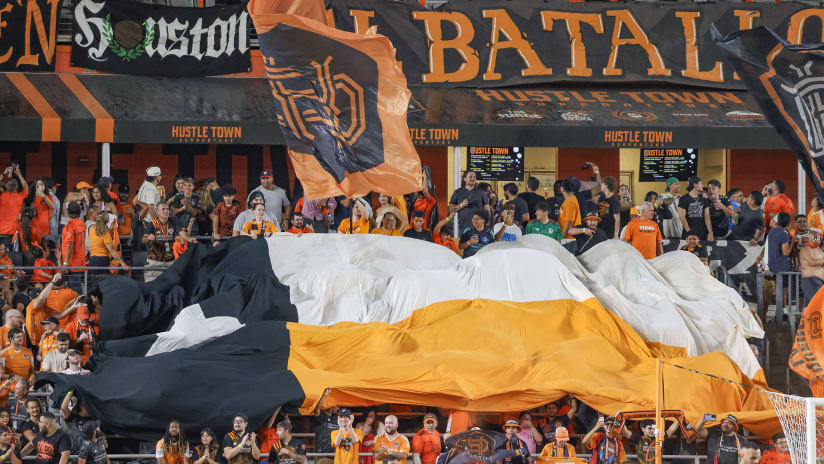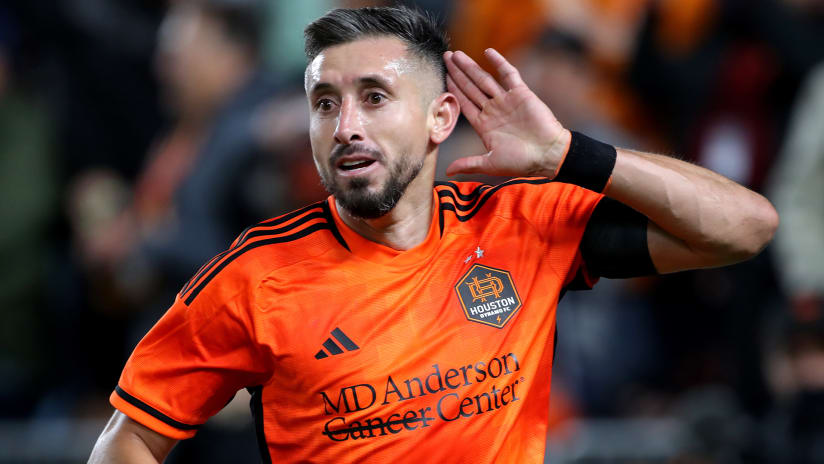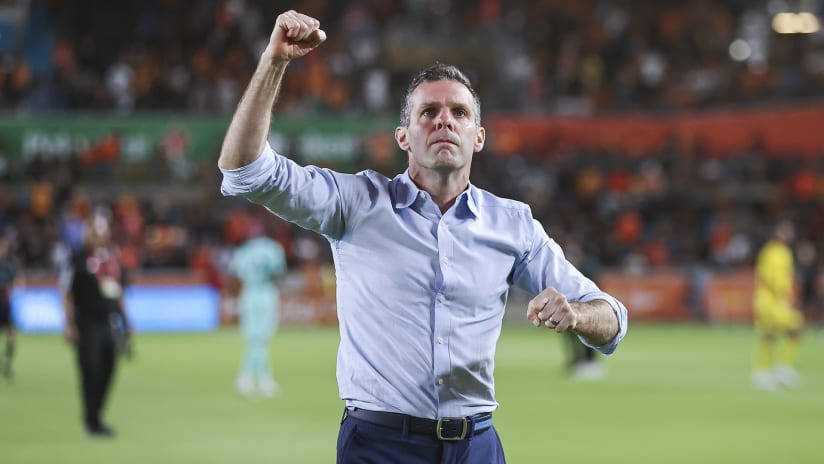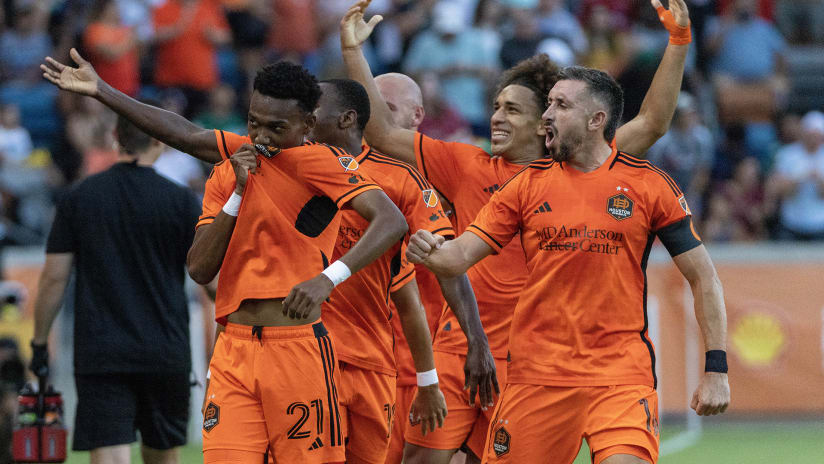Even with seasonal tropical thunderstorms rolling through Fort Lauderdale all week, the forecast calls for a starry night at DRV PNK Stadium on Wednesday. As has been the case for most of Inter Miami CF’s matches since the arrival of Lionel Messi, a big crowd rife with VIPs is expected as the Herons host Houston Dynamo FC for the US Open Cup Final (8:30 pm ET | CBS Sports Network, Telemundo).
Ted Segal might not be quite as recognizable to the casual viewer as David and Victoria Beckham, the myriad other celebrities who flock to DRV PNK, or even his Dynamo co-investor James Harden. Yet he’s a key reason, perhaps even the reason, La Naranja have reached this point, while also climbing into the upper echelons of the MLS Western Conference standings in what’s shaping up as Houston’s best season in years.
The Dynamo’s majority owner has invested massive amounts of time, money and attention into the club, which also includes their NWSL sibling side the Houston Dash, since taking the helm two years ago in a transaction that reportedly valued HDFC around $400 million.
Whatever the final scoreline, Wednesday represents a rewarding milestone in that journey.
“The immediate reaction upon seeing Coco Carrasquilla score the ultimately winning goal for us in the extra-time semifinal win over [Real Salt Lake] was elation. It was recognition that this is a great opportunity for our organization,” Segal told MLSsoccer.com in a wide-ranging sit-down conversation last week.
“A spotlight to be put on our club and the progress that we've made and the talent that we have, competing against arguably right now the league's very best, and certainly in a player like Messi and down the line, [Sergio\] Busquets and [Jordi\] Alba, some of the world's very best.”
Investment & potential
When he first arrived, Segal noted how often he’d heard the phrase ‘sleeping giant’ attached to the Dynamo. MLS’s first and only relocation case, they were a member of the MLS elite during their early years in the Bayou City, winning the 2006 and 2007 MLS Cups and reaching the cup finals in 2011 and 2012 before slipping into chronic underachievement for most of the past decade.
Yet with a downtown stadium at the heart of the fifth-largest metropolitan area in the United States, home to a thriving economy and a massive, heavily Hispanic local soccer community, so much alluring possibility hangs in the warm air of H-town.
“I'll just tell you, it's no secret: When I see that our club is a laggard on certain metrics when I'm at these ownership meetings, it burns me up inside,” said Segal. “I'm a competitive person. I know what the potential of the city is. And I know that it is flowing through our organization, that desire to be back up in the upper echelon, not just on the field but as a business.”

He and his partners have not lacked ambition in that regard.
Last summer brought the landmark signing of Mexican international Héctor Herrera, whose salary is the sixth-highest in the league according to MLS Players Association documents, and whose 2023 Best XI presented by Continental Tire-caliber performances have this year caught up to that expenditure.
There have been other major outlays, like club-record transfer Sebastián Ferreira (who’s currently out on loan at Brazil’s Vasco da Gama) and the reshaping of Houston’s technical staff, as well as a partnership with SRC FTBL, an analytics consulting firm led by Ravi Ramineni (a key architect of the Seattle Sounders’ pioneering deployment of data) and Sarah Rudd, two of the most respected names in the field.
Then there’s the $30 million and counting in infrastructure and fan-experience upgrades, plus a new naming-rights deal, at their home ground, Shell Energy Stadium. That includes new mesh seats across the venue, a new 15,000-square-foot premium club space and rooftop solar array, LED lighting and other "decarbonization" efforts to reduce the club's greenhouse gas emissions by half.
La Naranja also continue to direct significant focus towards upgrading their academy system, which despite sustained endeavor has generally struggled to capitalize on the sprawling region’s deep pool of youth talent to anywhere near the extent their in-state rivals FC Dallas have done in North Texas.
Segal is also the founder and president of EJS Group, a New York real estate development and financing company – his “day job,” as he calls it. So he’s been racking up the miles from his home base in the Empire State to Houston, making sure all those changes around the Dynamo are administered with a personal touch.
“There's only one way to do this, and this is to be present on the ground,” he explained. “And if you actually aren't living here, then you’ve got to spend a heck of a lot of time here. I think I'm a relatively young guy, 42 years old, so I can handle it.
“I'll say that none other than Héctor Herrera implored me that I need to be down here more,” he added, “and I don't take that lightly. He jokingly calls me ‘the big boss man,’ and said that I’ve got to be here more and set the example, and he's right. And so I'm here several times a month, and I'm doing whatever I can in small part, because there's a lot of other people in this organization that are doing a heck of a lot more to get this organization to where we all want it to be.”

Legacy to modern
With the Dynamo set to vie for their second Open Cup title (won in 2018) and on course for an Audi 2023 MLS Cup Playoffs berth, quite possibly in the top half of the bracket, which grants at least one round of home-field advantage, he sees both near- and long-term progress, even if the day-to-day process can be painstaking.
“To do this right, it has to be immersive,” said Segal. “As much as you think you know leading up to the acquisition and the diligence process, you don't know the half of it until you actually get under the hood and you're the controlling owner.”
Segal speaks of a three-pronged mantra:
- Consistently competing for championships.
- Providing positive, meaningful experiences for fans regardless of on-field results.
- Making an impact in the community via Dynamo and Dash charity efforts.
That points to the urgency of making HDFC both a good neighbor and an entertainment product worth revisiting, hence the early emphasis on making their stadium and its East Downtown surroundings more inviting.
“East Downtown is unique and special, and we have gone about efforts to expand our footprint here,” said Segal. “We've acquired several tracts of land at this point that we have a blank canvas to, in tandem with some of the other folks who are investing in this area, really enhance the experience, pre- and post-game. Notably, we moved our entire organization's business operations to a building a block away from our stadium. Now our entire staff is in a 26,000-square foot, newly renovated office building, working where we play.”
Houston is one of a few ‘legacy’ markets that present both upsides and obstacles for MLS, a markedly different proposition from the expansion process in newer markets. MLS Commissioner Don Garber has used the phrase “it’s easier to be new than improved” in that context, and Segal nods knowingly when presented with those words.
“I think at a certain level, our new entrants have benefited from the efforts of our legacy clubs in the growth of MLS over the last 20 years, so that they can step into a league that is at the level of quality of play, of fan enthusiasm, of revenue, that they can build $300-$400 million stadiums,” he said. “When you’re MLS 1.0 or 2.0, we are a little behind in what I call the stadium arms race.
“So taking what was a sub-$100 million capital-cost building that's not that old, only 10 years old, and trying to transform it, or get it up to the standards of what some of our friends have, doesn't happen overnight. But it's something that we're intent on doing year over year. So this building is going to be a work in progress every year. We're going to make enhancements to it … if we're able to execute and improve rather than coming in new, I think it'll be a great accomplishment for our organization and our standing in the league.”

Room to grow
Everything’s easier with a winning product on the pitch. In that regard, Segal praises general manager Pat Onstad, technical director Asher Mendelsohn and first-year head coach Ben Olsen for their roster overhaul, marked by 17 new roster additions and a focus on locker-room chemistry which seems to be paying off.
“They really focused on having a culture of success permeate the organization, bringing in players who have competed for championships in MLS, outside MLS, and changing what was a culture of complacency before,” said Segal, pointing to a 1-1 home draw with West leaders St. Louis CITY SC on Sept. 16 in which the Orange conceded an 88th-minute equalizer.
“In the past, maybe some of the members of our roster would’ve thought that was inevitable,” he explained. “Here it was intolerable. Our guys expected three points, and it's a complete 180 shift in terms of the mentality and that's, I think, very pivotal in getting the results that we've seen this year.”










